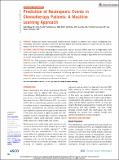| dc.contributor.author | Wiberg, Holly | |
| dc.contributor.author | Yu, Peter | |
| dc.contributor.author | Montanaro, Pat | |
| dc.contributor.author | Mather, Jeff | |
| dc.contributor.author | Birz, Suzi | |
| dc.contributor.author | Schneider, Michelle | |
| dc.contributor.author | Bertsimas, Dimitris | |
| dc.date.accessioned | 2022-07-27T17:34:13Z | |
| dc.date.available | 2022-07-27T17:34:13Z | |
| dc.date.issued | 2021 | |
| dc.identifier.uri | https://hdl.handle.net/1721.1/144085 | |
| dc.description.abstract | <jats:sec><jats:title>PURPOSE</jats:title><jats:p> Severe and febrile neutropenia present serious hazards to patients with cancer undergoing chemotherapy. We seek to develop a machine learning–based neutropenia prediction model that can be used to assess risk at the initiation of a chemotherapy cycle. </jats:p></jats:sec><jats:sec><jats:title>MATERIALS AND METHODS</jats:title><jats:p> We leverage rich electronic medical records (EMRs) data from a large health care system and apply machine learning methods to predict severe and febrile neutropenic events. We outline the data curation process and challenges posed by EMRs data. We explore a range of algorithms with an emphasis on model interpretability and ease of use in a clinical setting. </jats:p></jats:sec><jats:sec><jats:title>RESULTS</jats:title><jats:p> Our final proposed model demonstrates an out-of-sample area under the receiver operating characteristic curve of 0.865 (95% CI, 0.830 to 0.891) in the prediction of neutropenic events on the basis of only 20 clinical features. The model validates known risk factors and offers insight into potential novel clinical indicators and treatment characteristics that elevate risk. It relies on factors that are directly extractable from EMRs, provided a tool can be easily integrated into existing workflows. A cost-based analysis provides insight into optimal risk thresholds and offers a framework for tailoring algorithms to individual hospital needs. </jats:p></jats:sec><jats:sec><jats:title>CONCLUSION</jats:title><jats:p> A better understanding of neutropenic risk on an individual level enables a more informed approach to patient monitoring and treatment decisions. </jats:p></jats:sec> | en_US |
| dc.language.iso | en | |
| dc.publisher | American Society of Clinical Oncology (ASCO) | en_US |
| dc.relation.isversionof | 10.1200/CCI.21.00046 | en_US |
| dc.rights | Creative Commons Attribution-Noncommercial-Share Alike | en_US |
| dc.rights.uri | http://creativecommons.org/licenses/by-nc-sa/4.0/ | en_US |
| dc.source | MIT web domain | en_US |
| dc.title | Prediction of Neutropenic Events in Chemotherapy Patients: A Machine Learning Approach | en_US |
| dc.type | Article | en_US |
| dc.identifier.citation | Wiberg, Holly, Yu, Peter, Montanaro, Pat, Mather, Jeff, Birz, Suzi et al. 2021. "Prediction of Neutropenic Events in Chemotherapy Patients: A Machine Learning Approach." JCO Clinical Cancer Informatics, (5). | |
| dc.contributor.department | Massachusetts Institute of Technology. Operations Research Center | |
| dc.contributor.department | Sloan School of Management | |
| dc.relation.journal | JCO Clinical Cancer Informatics | en_US |
| dc.eprint.version | Author's final manuscript | en_US |
| dc.type.uri | http://purl.org/eprint/type/JournalArticle | en_US |
| eprint.status | http://purl.org/eprint/status/PeerReviewed | en_US |
| dc.date.updated | 2022-07-27T17:21:47Z | |
| dspace.orderedauthors | Wiberg, H; Yu, P; Montanaro, P; Mather, J; Birz, S; Schneider, M; Bertsimas, D | en_US |
| dspace.date.submission | 2022-07-27T17:21:48Z | |
| mit.journal.issue | 5 | en_US |
| mit.license | OPEN_ACCESS_POLICY | |
| mit.metadata.status | Authority Work and Publication Information Needed | en_US |
